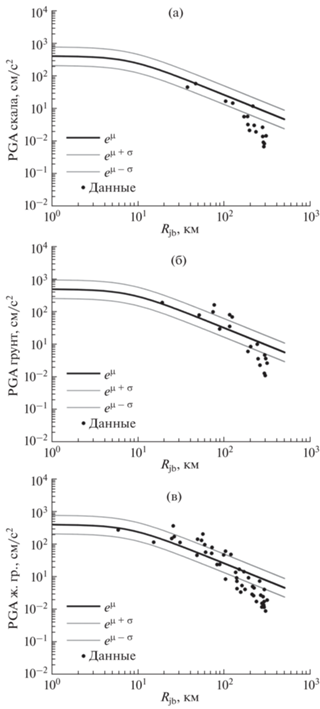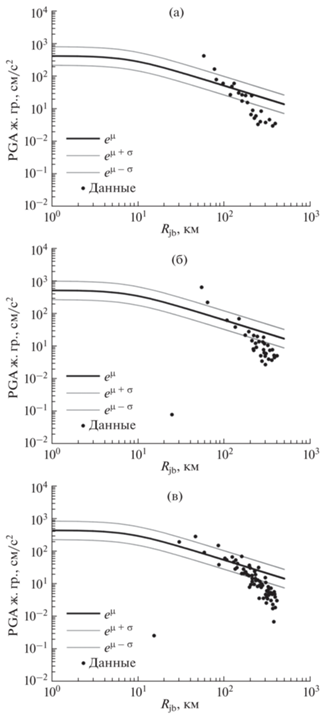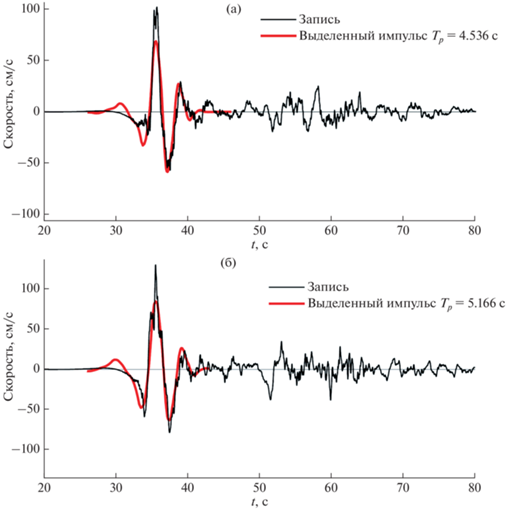Физика Земли, 2023, № 6, стр. 103-121
Эффекты направленности излучения крупных очагов на примере катастрофических землетрясений в Турции 06.02.2023 г.*
О. В. Павленко 1, *, В. А. Павленко 1, **
1 Институт физики Земли им. О.Ю. Шмидта РАН
г. Москва, Россия
* E-mail: olga@ifz.ru
** E-mail: pavlenko.vasily@gmail.com
Поступила в редакцию 16.05.2023
После доработки 25.05.2023
Принята к публикации 13.06.2023
- EDN: LYNPBR
- DOI: 10.31857/S0002333723060145
Аннотация
Представлен обзор результатов, полученных зарубежными сейсмологами на основе записей сетей сейсмических наблюдений Турции AFAD (Государственного агентства по борьбе со стихийными бедствиями при Министерстве внутренних дел). Последовательность землетрясений началась с основного толчка M7.8 и насчитывает тысячи афтершоков. Наиболее сильные события произошли в первые двенадцать часов, причем очаги двух событий M7.0+ располагались в 100 км друг от друга. Землетрясения вызвали движения грунта, разрушительные для сооружений, так называемые “импульсные волновые формы”, и эпицентральные расстояния, как ранее отмечалось, не являются хорошим показателем затухания волн от землетрясений с протяженными разрывами. Записи станций в приразломных зонах четко выявили эффекты направленности сейсмического излучения. Землетрясение М7.8 (основной толчок) было более масштабным, чем ожидалось при текущей тектонической обстановке. По записям ближнего поля прослежен ранний переход к сверхскоростному (~1.55Vs) распространению разрыва на боковом разломе Нарли, где зародился разрыв, который затем перешел в Восточно-Анатолийский разлом. Ранний переход в сверхбыструю стадию очевидно способствовал дальнейшему распространению разрыва и инициированию подвижек на Восточно-Анатолийском разломе. Построена динамическая модель разрыва, которая согласует полученные разными авторами различные результаты инверсий и выявляет пространственно неоднородные скорости распространения трещины. Сверхбыстрые скорости, превышающие скорость поперечных волн Vs, наблюдаются вдоль бокового разлома Нарли и на юго-западном конце Восточно-Анатолийского разлома. С конца 1990-х годов сейсмологи работают над включением эффектов направленности излучения протяженных очагов в процедуры ВАСО (вероятностного анализа сейсмической опасности), однако к настоящему времени консенсус не достигнут, и прогресса в этой области можно ожидать лишь с накоплением достаточного количества данных наблюдений.
ВВЕДЕНИЕ
06.02.2023 г., в 4:17 по местному времени (UTC+3), в турецкой провинции Газиантеп произошло землетрясение с моментной магнитудой 7.8. Землетрясение положило начало сейсмической последовательности из сотен землетрясений с магнитудами более трех, включавшей события с магнитудами Mw = 7.6 и Mw = 6.7. Эпицентральные области землетрясений простираются на несколько сотен километров на востоке Турции, вблизи границы с Сирией; вместе с Северо-Анатолийской системой разломов и западной частью Турции это наиболее сейсмически опасные области, согласно ВАСО.
На рис. 1 показана карта сейсмической опасности Турции в терминах пиковых ускорений (PGA) на скальных грунтах с периодом повторяемости ~475 лет.
Рис. 1.
Карта сейсмического районирования Турции в терминах пиковых ускорений (PGA) для периода повторяемости 475 лет [Giardini et al., 2018]. Прямоугольник обрамляет эпицентральные зоны происшедших землетрясений.
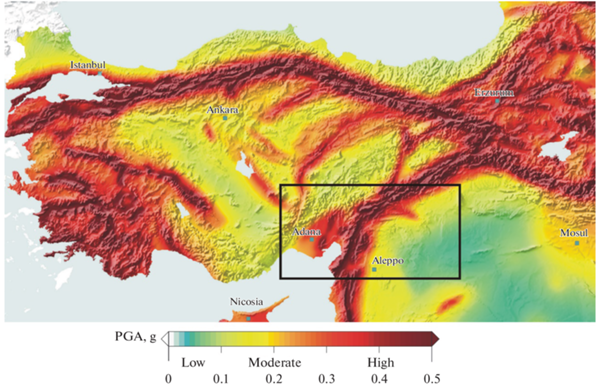
В работе [Baltzopoulos et al., 2023] изучается последовательность турецких землетрясений. В табл. 1 из работы [Baltzopoulos et al., 2023] приведены координаты эпицентров трех основных событий последовательности, глубины гипоцентров и механизмы разломов.
Таблица 1.
Данные о трех событиях наибольшей магнитуды в последовательности землетрясений
| Дата | Время (UTC+3) | Магнитуда | с.ш., ° | в.д., ° | Глубина, км | Механизм* |
|---|---|---|---|---|---|---|
| 06-02-2023 | 04:17:36 | 7.8–7.7 | 37.08 | 37.17 | 20 | Strike-Slip |
| 06-02-2023 | 04:28:19 | 6.7– 6.6 | 36.81 | 37.13 | 40 | Strike-Slip |
| 06-02-2023 | 13:24:49 | 7.5–7.6 | 37.24 | 38.11 | 10 | Strike-Slip |
За основным толчком последовали афтершоки; в первые сутки – в среднем, около пятнадцати событий в час; их эпицентры показаны на рис. 2. Форшоки не были зарегистрированы.
Рис. 2
Эпицентры событий M7.0+ и афтершоков (черные и серые звезды), показывающие разломную плоскость основного толчка (из работы [Baltzopoulos et al., 2023]) и акселерограммы станций, ближайших к эпицентру события М7.8 (из работ [Baltzopoulos et al., 2023; Malhotra, 2023; Garini, Gazetas, 2023]).
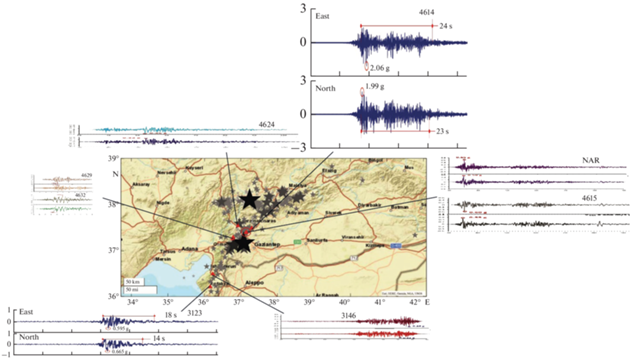
Примерно через десять минут после основного толчка и менее чем в 25 км от его эпицентра произошло событие M6.7. В течение первого часа было зарегистрировано девять землетрясений магнитудой выше пяти; для сравнения, такое же количество событий M5.0+ было зарегистрировано во время продолжительной сейсмической последовательности в Центральной Италии в 2016–2017 гг. [Iervolino et al., 2021], но за пять месяцев.
Второе по силе событие серии M7.5 произошло примерно в 100 км к северу от основного толчка, за которым последовали пять M5.0+ в течение следующих девяноста минут. Менее чем за полдня на Турцию обрушилось около ста восьмидесяти землетрясений, два из которых магнитудой более семи.
В работе [Baltzopoulos et al., 2023] PGA горизонтальных зарегистрированных движений грунта, полученные AFAD, сравниваются со средними значениями (плюс/минус одно стандартное отклонение) уравнения прогноза движений грунта GMPE [Bommer et al., 2012], разработанного для региона Европы и Ближнего Востока. Для этого сравнения эпицентральное расстояние, указанное для каждой записи, преобразуется в расстояние Джойнера–Бура (Rjb) в соответствии с методикой [Montaldo et al., 2005].
На рис. 3, рис. 4 и рис. 5 из работы [Baltzopoulos et al., 2023] показаны PGA, зарегистрированные при трех землетрясениях 06.02.2023 г.: основной толчок M7.8 – в 4:17, M6.6 – в 4:28, и M7.6 – в 13:24 по местному времени (UTC+3).
Рис. 3.
PGA, зарегистрированные при землетрясении M7.8, и GMPE [Bommer et al., 2012]: (а) – для скального грунта (Vs30 > 750 м/с), (б) – для мягкого грунта (Vs30 ≤ 360 м/с) и (в) – для жесткого грунта (360 < Vs30< = 750 м/с).
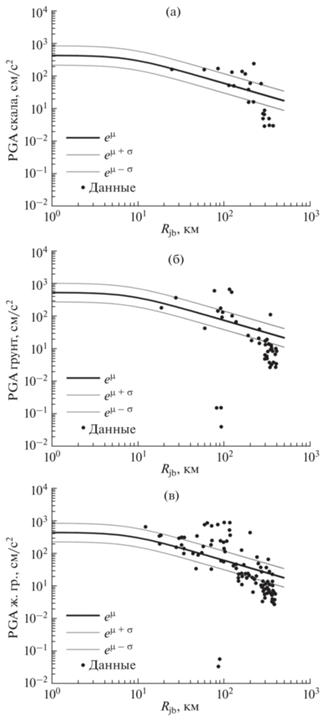
Как видно из рис. 3–рис. 5, (1) данные отсутствуют для Rjb менее 10 км, (2) в среднем диапазоне расстояний (от 10 до 100 км) в целом есть соответствие между зарегистрированными данными и результатами GMPE, (3) записи полученные на Rjb > 100 км дают PGA ниже значений, предоставленных выбранным GMPE.
Всего получено 274 записи события M7.8; из них – 23 на скальном грунте, 46 – на мягких грунтах и 103 – на плотных грунтах; для остальных 174-х Vs30 неизвестно. Получено 135 записей землетрясения М6.6: 17 на скальном грунте, 19 на мягком грунте, 52 на плотных грунтах и 47 на неизвестных грунтах. И получено 240 записей землетрясения M7.6: 25 из них на скальных грунтах, 38 – на мягких грунтах, 81 – на плотных грунтах; для остальных 96-ти Vs30 неизвестно.
В табл. 2 из работы [Baltzopoulos et al., 2023] приведены сведения о 10-ти сейсмостанциях, зарегистрировавших наиболее высокие пиковые ускорения при землетрясении M7.8: коды станций, их координаты, пиковые ускорения (PGA) для двух горизонтальных и одной вертикальной компонент и эпицентральные расстояния.
Таблица 2.
Данные о станциях, ближайших к эпицентру события M7.8
| Код станции | с.ш. | в.д. | PGA_NS, см/с2 | PGA_EW, см/с2 |
PGA_UD, см/с2 | Repi |
|---|---|---|---|---|---|---|
| 4615 | 37.14 | 37.39 | 587.70 | 556.41 | 664.56 | 18.23 |
| NAR | 37.16 | 37.39 | 646.52 | 578.79 | 398.66 | 19.48 |
| 3144 | 36.49 | 36.76 | 611.28 | 763.43 | 451.65 | 73.56 |
| 3137 | 36.49 | 36.69 | 453.07 | 847.97 | 501.96 | 78.72 |
| 3145 | 36.41 | 36.65 | 600.06 | 696.45 | 663.17 | 87.50 |
| 3142 | 36.37 | 36.50 | 646.63 | 749.52 | 505.90 | 102.53 |
| 0201 | 38.27 | 37.76 | 474.07 | 879.99 | 318.99 | 121.71 |
| 3124 | 36.17 | 36.24 | 572.30 | 638.26 | 578.12 | 136.06 |
| 3123 | 36.16 | 36.21 | 655.35 | 593.89 | 867.60 | 138.94 |
| 3132 | 36.17 | 36.21 | 515.27 | 514.56 | 354.15 | 139.02 |
В табл. 3 и табл. 4 представлены данные о 10-ти сейсмостанциях, наиболее близких к эпицентрам событий M6.6 и M7.6.
Таблица 3.
Данные о станциях, ближайших к эпицентру события M6.6
| Код станции | с.ш. | в.д. | PGA_NS, см/с2 | PGA_EW, см/с2 |
PGA_UD, см/с2 |
Repi |
|---|---|---|---|---|---|---|
| 4616 | 36.84 | 37.38 | 233.01 | 259.80 | 145.89 | 10.74 |
| 2712 | 36.73 | 37.18 | 445.29 | 336.80 | 319.34 | 21.27 |
| NAR | 37.16 | 37.39 | 61.86 | 137.37 | 55.95 | 23.15 |
| 4624 | 36.92 | 37.54 | 146.37 | 182.10 | 79.52 | 25.81 |
| 4617 | 36.83 | 37.59 | 116.28 | 147.62 | 33.94 | 32.29 |
| 2708 | 36.65 | 37.10 | 312.95 | 355.45 | 208.24 | 33.12 |
| 8002 | 36.56 | 37.19 | 127.15 | 163.64 | 125.62 | 34.07 |
| 2718 | 36.63 | 37.01 | 220.03 | 308.99 | 129.75 | 41.97 |
| 2716 | 36.69 | 36.86 | 86.90 | 179.51 | 72.34 | 53.84 |
| 3143 | 36.56 | 36.85 | 113.80 | 136.46 | 75.55 | 59.98 |
Таблица 4.
Данные о станциях, ближайших к эпицентру события M7.6
| Код станции | с.ш. | в.д. | PGA_NS, см/с2 | PGA_EW, см/с2 |
PGA_UD, см/с2 |
Repi |
|---|---|---|---|---|---|---|
| 4408 | 37.89 | 38.10 | 52.37 | 142.29 | 275.29 | 56.74 |
| 4409 | 37.49 | 38.56 | 214.22 | 150.23 | 62.29 | 56.86 |
| 4612 | 36.48 | 38.02 | 637.92 | 522.63 | 372.97 | 66.68 |
| 4406 | 37.97 | 38.34 | 428.25 | 373.32 | 286.23 | 70.17 |
| 3802 | 36.50 | 38.48 | 193.76 | 218.62 | 118.06 | 77.41 |
| 0129 | 36.21 | 38.26 | 149.67 | 166.27 | 80.81 | 91.84 |
| 4405 | 37.94 | 38.81 | 136.82 | 149.87 | 83.11 | 100.81 |
| 0141 | 35.53 | 37.56 | 78.64 | 189.25 | 74.48 | 161.28 |
В работе [Baltzopoulos et al., 2023] рассчитана интенсивность по Ариаз и спектры отклика по ускорениям с затуханием 5% для всех станций. Спектры отклика показывают максимумы на 0–1 с на малых эпицентральных расстояниях (до 20 км) и более широкий диапазон 0–2 с на бóльших расстояниях (до 140 км), но бывают и узкополосные спектры на больших расстояниях. По графикам спектров отклика можно видеть, что при всех трех землетрясениях регистрировались движения грунта, способные вызвать большие разрушения построек: спектральные амплитуды достигали 2.8 g [Baltzopoulos et al., 2023].
ПРОЯВЛЕНИЯ ЭФФЕКТОВ НАПРАВЛЕННОСТИ СЕЙСМИЧЕСКОГО ИЗЛУЧЕНИЯ ИЗ ОЧАГОВ ТУРЕЦКИХ ЗЕМЛЕТРЯСЕНИЙ 2023 г. ИМПУЛЬСОПОДОБНЫЕ ДВИЖЕНИЯ ГРУНТА
Анализ сейсмических записей, полученных при Турецких землетрясениях, показывает, что на больших эпицентральных расстояниях в некоторых случаях не наблюдается существенного ослабления сейсмических колебаний, очевидно, из-за больших размеров разломной зоны, т.е. из-за эффектов направленности сейсмического излучения [Baltzopoulos et al., 2023].
Также сейсмологи отмечают масштабные разрушения, наблюдавшиеся при землетрясениях: в общей сложности около 5000 зданий разрушено в 10-ти провинциях Турции; 10 крупных городов серьезно пострадали от разрушенных зданий.
Очевидно, одной из причин разрушений могли быть наблюдавшиеся так называемые “импульсоподобные волновые формы” (pulse-like features).
Давно замечено, что иногда движения грунта при землетрясении вблизи разлома характеризуются наличием импульсов ускорения большой продолжительности, которым соответствуют импульсы скорости необычно большой величины. Эти импульсы появляются в результате того, что разрыв в очаге землетрясения распространяется в направлении данного пункта наблюдения (forward propagation). Эти импульсы, как правило, сильнее выражены на горизонтальных компонентах, ориентированных перпендикулярно разлому. Эффекты направленности могут возникать при разных механизмах очагов, как strike-slip, так и dip-slip, при сбросах или взбросах.
Изучение теоретических моделей дислокаций для понимания кинематики движений грунта в ближнем поле идет давно [Anderson, Bertero, 1987], однако после землетрясений 1994 г. в Нортридже и 1995 г. в Кобе эта тема получила особое развитие. Эмпирический анализ записей сильных движений, сделанных вблизи разломов, и проверка широкополосным моделированием, позволили сформулировать предложения по количественной оценке этих эффектов для корректировки существующих эмпирических кривых затухания, для учета эффектов направленности разрыва в среднем [Somerville et al., 1995] и учета эффектов прямой направленности разрыва [Abrahamson, 1998; Somerville et al., 1996].
Движения грунта с импульсом в начале велосиграммы рассматриваются инженерными сейсмологами как особый класс движений грунта, которые вызывают серьезные повреждения конструкций. Такой тип движений импульсного характера обычно наблюдается на участках, расположенных вблизи разлома, поскольку он вызван главным образом эффектами направленности сейсмического излучения [Somerville et al., 1997; Somerville, 2003; 2005; Spudich, Chiou, 2008].
Импульсоподобные движения грунта приводят к усилению спектров отклика инженерных сооружений (обычно узкополосному, что переводит сооружение в область неупругости на этих частотах), поэтому они представляют более серьезную угрозу для сооружений, чем сильные движения неимпульсных форм, по крайней мере, в среднем [Baez, Miranda, 2000; Iervolino et al., 2012; Shahi, Baker, 2011].
Таким образом, импульсные движения грунта предъявляют серьезные требования к сооружениям и, как известно, уже причинили значительный ущерб при прошлых землетрясениях, что описано например, в работах [Bertero et al., 1978; Anderson, Bertero, 1987; Hall et al., 1995; Iwan, 1997; Alavi, Krawinkler, 2001; Menun, Fu, 2002; Makris, Black, 2004; Mavroeidis et al., 2004; Akkar et al., 2005; Luco, Cornell, 2007].
Влияние импульсного характера велосиграмм в приразломных зонах на реакцию инженерных конструкций было впервые показано при землетрясении в Сан-Фернандо 1971 г. авторами работ [Mahin et al., 1976; Bertero et al., 1977]. После землетрясения 1979 г. в Империал Вэлей авторы работы [Anderson, Bertero, 1987] определили инкремент скорости как важный параметр, влияющий на максимальный неупругий отклик конструкций при воздействии на них сильных движений в приразломных зонах.
После землетрясений 1994 г. в Нортридже и 1995 г. в Кобе в Единый строительный кодекс (UBC) 1997 г. были введены факторы близости источника [UBC, 1997]. Эти коэффициенты варьируют от 1.0 до 2.0 в зависимости от типа источника и ближайшего расстояния до известного сейсмического очага. Однако эти коэффициенты были введены на основе ограниченных данных и исследований и явно не учитывают разницу между воздействием движений грунта в приразломных зонах на упругую и неупругую реакцию структуры. В других рекомендациях по проектированию введены коэффициенты, в явном виде учитывающие требования к максимальному неупругому и максимальному упругому боковому смещению [ATC, 1996; FEMA, 1997]. Эти коэффициенты позволяют оценить максимальные неупругие смещения, используя результаты линейного упругого анализа.
Как сказано выше, наиболее известными причинами появления импульсоподобных волновых форм движения грунта являются эффекты, наблюдаемые вблизи источника, такие как направленность разрыва или взброс. На участках, расположенных вдоль направления распространения разрыва, может наблюдаться почти одновременный приход поперечных волн, излучаемых распространяющейся трещиной в разных точках плоскости разрыва. Эти так называемые эффекты направленности и проявляются в велосиграммах движений грунта, где конструктивная интерференция волн может вызывать значительные по величине двусторонние импульсы [Somerville et al., 1997].
В работе [Baltzopoulos et al., 2023] сейсмические записи, полученные вблизи разломных плоскостей трех крупных Турецких землетрясений, проанализированы на предмет присутствия в них импульсоподобных волновых форм. На предварительном этапе анализа записей, из-за отсутствия достаточной информации о геометрии разлома и подвижках на разломе, анализ ограничивается характеристикой некоторых записей вблизи источника как импульсоподобных на основании только особенностей волновых форм, без учета физического процесса разрыва в зависимости от местоположения станции.
В исследование было включено по десять записей каждого из трех землетрясений (табл. 2, табл. 3, табл. 4); в общей сложности тридцать. Велосиграммы получены путем интегрирования акселерограмм на горизонтальных компонентах; изучался результирующий вектор на горизонтальных компонентах при повороте его более чем на сто восемьдесят градусов с шагом в один градус. Для каждой ориентации применен объединенный алгоритм вейвлет-анализа для идентификации возможных импульсных сигналов во временных рядах велосиграмм [Baker, 2007], и сделаны оценки показателя импульса (PI). Движения грунта предварительно характеризовались как импульсоподобные, если они демонстрировали стабильно высокий балл PI > 0.90 по дуге более 60°, а также демонстрировали удовлетворительное совпадение спектров псевдоскоростей движения грунта и потенциального импульсного вейвлета на периодах импульса Tp [Baltzopoulos et al., 2020].
В результате шесть записей из тридцати исследованных были характеризованы как импульсоподобные (рис. 6); они выделены жирным шрифтом в табл. 2–табл.4. Это записи станций с кодами NAR и 4615 от основного толчка M7.8, запись станции 4612 от события M7.6 и записи станций 2708, 2718 и 4616 от события M6.6. Все периоды идентифицированных импульсов несколько ниже медианных прогнозов с учетом величин, полученных из регрессионных моделей. Например, одна из таких моделей предсказала бы медиану Tp в 7.5 с, 6.7 с и 2.4 с для Mw 7.8, 7.6 и 6.6 соответственно [Baltzopoulos et al., 2023].
РАННИЙ ПЕРЕХОД К СВЕРХБЫСТРОМУ РАСПРОСТРАНЕНИЮ РАЗРЫВА В ОЧАГЕ ЗЕМЛЕТРЯСЕНИЯ В КАРАМАНМАРАШЕ M7.8 [ROSAKIS ET AL., 2023]
Предварительные модели развития подвижки в очаге землетрясения 06.02.2023 г. М7.8, основанные на телесейсмических данных и многочисленных инверсиях, показывают, что разрыв начался в 4:17:355 по местному времени на боковом разломе-ответвлении в непосредственной близости от Восточно-Анатолийского разлома. Точное местоположение гипоцентра в настоящее время неизвестно. Предварительное местоположение гипоцентра оценено AFAD как 37.288° с.ш. 37.042° в.д., а глубина ~8 км. Согласно данным Геологической Службы США (USGS) координаты гипоцентра 37.166° с.ш. 37.042° в.д. ±6.3 км (обозначено красной звездой на рис. 7) и глубина ~18.3 км.
Разрыв распространялся на северо-восток, впоследствии переместившись в Восточно-Анатолийский разлом и положив начало последовательности сейсмических событий. Последующие геодезические инверсии подтвердили многосегментный характер разрыва М7.8. Землетрясения привели к катастрофическим разрушениям и значительным гуманитарным и финансовым потерям.
Масштаб события и общая длина разрывов оказались существенно больше, чем ожидалось на основе анализа исторических записей и текущей тектонической обстановки на юге Турции [Acarel et al., 2019]: магнитуда крупнейшего землетрясения, произошедшего на Восточно-Анатолийском разломе за последние несколько сотен лет, составляет 7.2. Наряду с интенсивностью измеренных сильных движений, это побудило группу исследователей из США A. Rosakis, M. Abdelmeguid, A. Elbanna [Rosakis et al., 2023] исследовать природу инициирования разрыва, его распространения, и возможность его раннего перехода в сверхзвуковой режим.
Рис. 7 иллюстрирует предполагаемое положение гипоцентра, направление бокового разлома, который, судя по афтершокам, имел простирание ~22°, и направление подвижек: левостороннее как для бокового, так и для Восточно-Анатолийского разлома. Три станции расположены близко к боковому разлому (рис. 7): две из них, TK:NAR и KO:KHMN, в одном пункте с координатами 37.3919° с.ш. 37.1574° в.д.; это станции-близнецы. Третья станция, TK:4615, расположена ближе к эпицентру; ее координаты 37.386° с.ш. 37.138° в.д. Записи трех станций дают представление о характеристиках ближнего поля разрыва на боковом разломе; они представляют собой уникальные наблюдения [Rosakis et al., 2023].
Рис. 7.
Зона Восточно-Анатолийского разлома (EAF), предполагаемое положение гипоцентра (красная звезда) землетрясения Mw7.8. Пунктирная линия – предполагаемая трасса подвижки на боковом разломе, согласно записям AFAD. Зеленые ромбы указывают положения ближайших к следу разлома сейсмостанций. Черные стрелки – направление движения разлома. Вставка – схема расположения станций (из работы [Rosakis et al., 2023]).
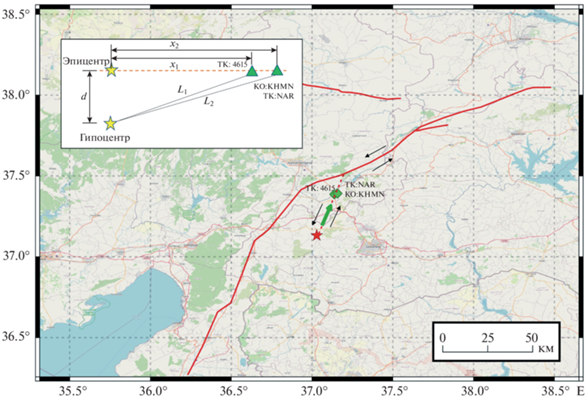
На рис. 8а показаны велосиграммы землетрясения M7.8 на станциях-близнецах TK:NAR и KO:KHMN в направлениях параллельно разлому, нормально к разлому и по вертикали. Станции оснащены разными приборами, и хорошее соответствие между записями дает уверенность в качестве данных.
Рис. 8.
Записи ближнего поля на станциях TK:NAR и KO:KHMN, указывающие на сверхбыстрое распространение разрыва: (a) – велосиграммы (с коррекцией за прибор) параллельно разлому, нормально разлому и по вертикали, полученные на станциях TK:NAR (черная линия) и KO:KHMN (красная линия). Синяя пунктирная линия показывает вступления P-волн, красная пунктирная линия – вступления фронта Маха волн сдвига, а черная пунктирная линия – вступления замыкающей волны, распространявшейся с субрелеевской скоростью; (б) – теоретическая зависимость между отношениями изменений скоростей FP и FN из-за прохождения фронта Маха и скоростью сверхзвукового разрыва, нормированной на скорость сдвиговой волны; (в) – схематический вид сверху, расположение станций (зеленые треугольники) и фронта Маха волн сдвига. Эпицентр – желтая звезда. Точка перехода отмечена зеленым квадратом с интервалом ошибок. Зеленая стрелка указывает направление распространения разрыва (из работы [Rosakis et al., 2023]).
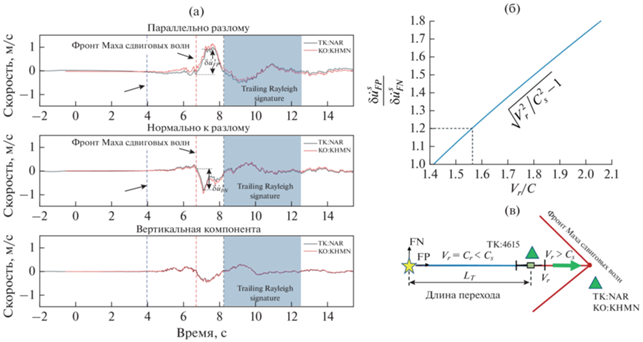
Велосиграммы на станциях-близнецах демонстрируют уникальные характеристики: (1) компонента FP больше, чем FN, что нетипично для “субрелеевских” разрывов, в которых преобладают компоненты по нормали к разрыву по сравнению с компонентами, параллельными разрыву. Доминирующий параллельный компонент – характерная особенность сверхскоростных разрывов [Rosakis et al., 1999], при которых скорость распространения разрыва превышает скорость волн сдвига. Такая особенность наблюдалась как в лабораторных [Mello et al., 2014; 2016], так и в полевых экспериментах [Mello et al., 2014; Dunham, Archuleta, 2004; Bouchon et al., 2001; Zeng et al., 2022], а также предсказана теорией [Mello et al., 2014; Dunham, Archuleta, 2004; Dunham, Bhat, 2008]. Это свидетельствует о распространении сверхзвукового разрыва в направлении станций-близнецов.
Мы наблюдаем сильные движения, связанные с приходом на станцию конуса Маха. Измеряя движение грунта, связанное с фронтом Маха, мы находим, что отношение параллельной разлому компоненты колебательной скорости к нормальной разлому компоненте составляет ~1.2. Как обсуждалось в работе [Mello et al., 2016], такие изменения обусловлены появлением сдвиговых фронтов Маха. Отношение колебательных скоростей, как теоретически показано в работе [Mello et al., 2016], однозначно зависит от отношения скорости распространения разрыва и скорости сдвиговой волны как $\sqrt {{{{\left( {{{{{V}_{r}}} \mathord{\left/ {\vphantom {{{{V}_{r}}} {{{V}_{s}}}}} \right. \kern-0em} {{{V}_{s}}}}} \right)}}^{2}} - 1} $. Эта взаимосвязь схематично показана на рис. 8б. Таким образом, для соотношения ~1.2 скорость сверхбыстрого разрыва равна ~1.5Vs. Черная пунктирная линия на рис. 8а указывает на возврат к распространению разрыва с субрелеевской скоростью, с которой разрыв распространялся до его перехода в сверхбыстрый режим. Вид сверху (рис. 8в) показывает расположение трех станций относительно эпицентра и длину перехода, после которого скорость распространения разрыва превышает скорость сдвиговой волны и прохождение конуса Маха на станциях-близнецах.
На рис. 9а показаны велосиграммы, полученные в направлениях параллельно разлому, нормально к разлому и по вертикали на станции TK:4615 (данные AFAD). Эти записи качественно отличаются от записей, представленных на рис. 8а. Действительно, здесь нормальная составляющая скорости больше, чем параллельная составляющая, что характерно для преимущественно субрелеевского распространения разрыва. Однако детальное изучение параллельной разлому велосиграммы указывает на наличие небольшого, но четко определенного импульса перед переходом к скорости волн Рэлея (заштрихованная область на рис. 9а).
Рис. 9.
Переход от субрелеевского к сверхбыстрому распространению разрыва фиксируется станцией TK:4615: (a) – велосиграммы в направлениях параллельно разлому, нормально к разлому и по вертикали. Выделенная область указывает на появление сверхзвукового импульса перед субрелеевским разрывом; (б) – схема расположения станций (зеленые треугольники) относительно эпицентра и гипоцентра (желтые звезды). Точка перехода отмечена зеленым квадратом с интервалами ошибок. Зеленая стрелка указывает направление распространения разрыва. Станция TK:4615 расположена вблизи точки перехода (из работы [Rosakis et al., 2023]).
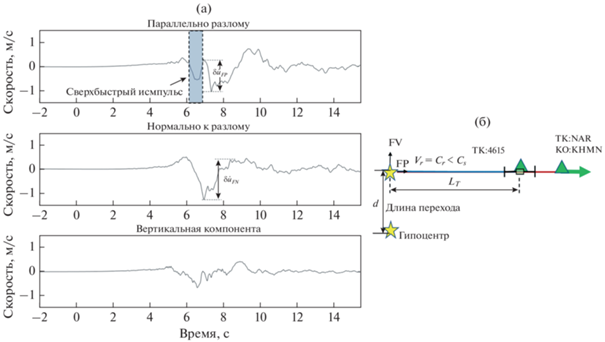
Авторы работы [Rosakis et al., 2023] полагают, что эта особенность является сверхзвуковым импульсом, который только что сформировался перед разрывом, который все еще распространяется со скоростью волн Рэлея. Они выдвигают гипотезу, что станция TK:4615 расположена очень близко к точке, где разрыв перешел от субрелеевского распространения к сверхбыстрому. Следует отметить, что вероятность захвата ранних стадий перехода от субрэлеевского разрыва к сверхбыстрому очень мала, и это никогда ранее не наблюдалось в записях в приразломных зонах. Однако такой переход наблюдался экспериментально в лабораторном моделировании землетрясений в экспериментах [Xia et al., 2004; Mello et al., 2016]. В частности, авторы работы [Mello et al., 2016], запечатлели такой переход, сравнивая динамические фотоизображения в начальных стадиях формирования сверхзвукового импульса с велосиграммами вблизи разлома. Велосиграммы были получены парой лазерных измерителей скорости, регистрирующих параллельную и нормальную к разлому компоненты [Mello et al., 2016].
Для проверки гипотезы о переходе к сверхбыстрому распространению разрыва в работе [Rosakis et al., 2023] выполнены расчеты: авторы предполагали Vs = 3320 м/с и Vp = 5780 м/с, что хорошо согласуется с оценками скоростей для региона Южной Турции [Acarel et al., 2019]. Тогда скорость волн Рэлея VR = 3050 м/с, и скорость распространения разрыва Vr = 4960 м/с. Из времени прихода P-волн на станции-близнецы и оценок скоростей, приведенных выше, для глубины гипоцентра 10.9 км получаем длину перехода ~19.45 км. Используя время прибытия P-волн на станцию TK:4615, получаем эпицентральное расстояние станции TK:4615 19.15 км. Таким образом, для глубины гипоцентра 10.9 км получаем, что положение станции TK:4615 совпадает с положением перехода от субрелеевского к сверхбыстрому распространению разрыва, что согласуется с гипотезой. Оценка глубины в 10.9 км – в пределах диапазона, предсказанного различными агентствами, AFAD и USGS. Также расстояние между станциями-близнецами и TK:4615 оценивается в ~1.6 км вдоль направления распространения разрыва. Поскольку расстояние между станциями-близнецами и TK:4615 составляет 2 км, эта оцененная разница в эпицентральных расстояниях – правдоподобная оценка.
Таким образом, анализ трех велосиграмм ближнего поля землетрясения в Кахраманмараше М7.8 показывает, что разрыв, распространявшийся по боковому разлому, перешел с субрелеевской скорости распространения на сверхбыструю (превышающую скорость S-волн) на эпицентральном расстоянии приблизительно 19.45 км. Записи ближнего поля впервые зафиксировали механизм перехода in situ от субрелеевского распространения к сверхбыстрому и дали представление о движениях среды вблизи разлома в параллельном разлому и в нормальном к разлому направлениях.
Поскольку фронты Маха лишь медленно ослабевают с расстоянием, этот ранний сверхбыстрый переход на боковом разломе вероятно способствовал передаче сильного динамического напряжения на близлежащий Восточно-Анатолийский разлом и продолжению распространения разрыва, вызвавшему скольжение как в северо-восточном, так и в юго-западном направлениях.
Действительно, прошлые исследования показали, что сверхбыстрые разрывы более эффективны при разрыве перемычек между разломами [Harris, Day, 1993] и при активации близлежащих разломов [Templeton et al., 2009; Rousseau, Rosakis, 2009; Bhat et al., 2004]. Раннему переходу к сверхбыстрому распространению на боковом разломе вероятно способствовало напряженное состояние среды в регионе. Сейсмологические исследования [Kartal et al., 2013] показали, что боковой разлом существовал в режиме сжатия в направлении N16.4° E и в режиме растяжения в направлении N80.8° W. Таким образом, простирание бокового разлома N22° E оказывается близким к направлению, перпендикулярному минимальному напряжению, что снижает общее нормальное напряжение на разломе , может значительно снизить параметр прочности при разрыве S (например, S < 1) [Xia et al., 2004; Andrews, 1976] и способствует переходу к сверхбыстрому разрыву на меньших расстояниях. Авторы работы [Rosakis et al., 2023] надеются, что дальнейшие исследования регионального поля напряжений и записей сильных движений позволят выявить больше деталей о природе этого сложного многосегментного разрыва, который привел к масштабной человеческой трагедии.
В своей новой работе коллектив авторов [Abdelmeguid et al., 2023] строит двумерную динамическую модель разлома землетрясения в Караманмараше на основе записей движения грунта, полевых исследований тектонической обстановки и геометрических особенностей следа разлома, с помощью которой они приводят физические аргументы для уточнения профиля скорости разрыва при конкурирующих кинематических инверсиях и дают представление о механизмах, которые способствовали сильным разрушениям и гуманитарным потерям при землетрясении.
Подобно работе [Rosakis et al., 2023], в этой работе исследованы записи скорости движения грунта параллельно разлому и нормально к разлому, но анализ расширен − включены все станции ближнего поля с полными и надежными записями. Станции классифицированы на основе отношения FP к FN (рис. 10).
Рис. 10.
Карта зоны Восточно-Анатолийского разлома (EAF), с предполагаемым местоположением гипоцентра землетрясения М7.8 и расположением станций (кружки), которые различаются по цветам, в соответствии с характеристиками наземной записи с субрелеевской скоростью распространения разрыва (синий цвет), сверх-сдвиговой (желтый цвет) и вероятной сверх-сдвиговой скоростью (красный цвет). Для станций, показывающих характеристики сверхзвукового сдвига, указаны отношения параллельной компоненты колебательной скорости к нормальной компоненте. Также показано в увеличенном виде расположение станций на южном конце трассы по данным USGS (из работы [Abdelmeguid et al., 2023]).
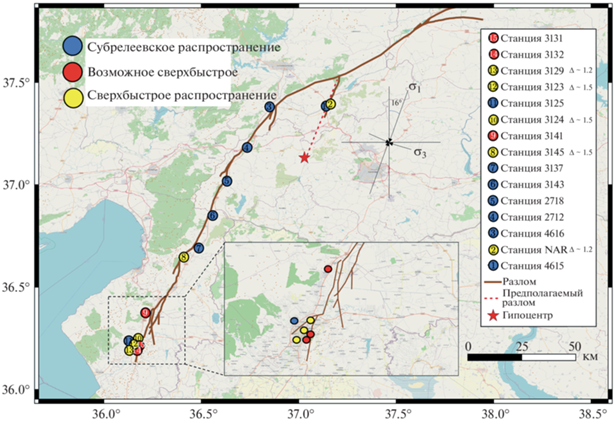
Записи движений грунта показывают три области, в которых скорость распространения разрыва превышала скорость поперечных волн Vs. Первая область, обнаруженная в работе [Rosakis et al., 2023], на разломе Нарли в непосредственной близости от гипоцентра. После перехода в Восточно-Анатолийский разлом разрыв распространился в двух направлениях: один конец распространился в северном направлении к Малатье, а другой – в юго–юго-западном направлении к Антакье.
Вдоль южного сегмента несколько станций, которые показывают на скорость разрыва в этом направлении. В частности, записи на станциях 2712, 3143, и 3137 показывают бóльшие компоненты FN по сравнению с FP, что указывает на субрелеевскую скорость распространения вдоль этого сегмента EAF. Станция 3145 показывает противоположное, т.е. доминирующую составляющую FP: соотношение FP и FN на этой станции составляет приблизительно 1.5, что означает, что разрыв распространяется со сверхвысокой скоростью. Расположение станции 3141 на изгибе разлома (рис. 10) указывает на то, что внезапное изменение смещения по разлому и, как следствие, изменение локального напряженного состояния могло способствовать переходу к разрыву с сильным сдвигом.
Также мы наблюдаем, что разрыв снова перешел к сверхбыстрому распространению ближе к южному концу трассы разлома, о чем свидетельствует множество станций. За исключением станции 3125, другие записи указывают на доминирующее соотношение FP к FN, однако соотношение варьирует между станциями. Возможно это объясняется сложностью сети разломов: многочисленные перегибы и разветвления сегментов на южной оконечности указывают на сложное напряженное состояние, которое способствует всплескам сверхбыстрых колебаний на некоторых сегментах и сложной форме волны, которая может скрывать признаки конуса Маха в других местах.
Анализ записей станций ближнего поля показывает, что распространение разрыва по разлому Нарли, а также по южному сегменту происходило со скоростями ниже Рэлеевской и сверхбыстрой. Из-за редкости станций вблизи соединения разлома Нарли с EAF, а также вдоль северной ветви EAF, у нас недостаточно информации, чтобы оценить скорость распространения разрыва.
Чтобы восполнить этот пробел, авторы построили динамическую модель разрыва, рассчитав параметры прочности S, характеристики трения и напряженного состояния в регионе. В исследованиях [Templeton et al., 2009] изучен широкий спектр углов разветвления разломов и показано, что для острых углов разветвления ~32°–35°, аналогичных углу между разломом Нарли и EAF, скорость трещины вдоль разветвления первоначально будет такой же или немного меньше, чем скорость ее распространения до ответвления.
Построенная динамическая модель разрыва, отражающая описанные выше ключевые особенности сложного события Mw7.8, дает оценки пиковой скорости, приведенные на рис. 11.
Рис. 11.
Распределение пиковых скоростей (PGV), полученное в результате численного моделирования динамического разрыва (из работы [Abdelmeguid et al., 2023]).
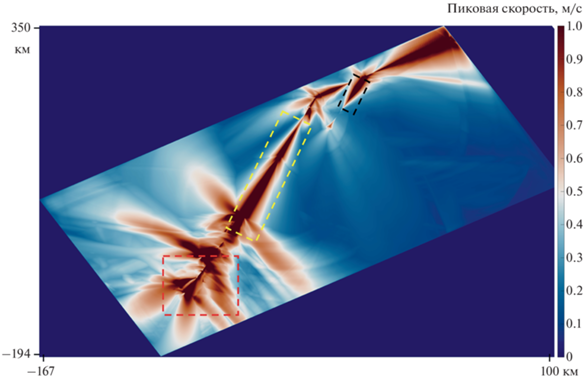
Распределение пиковых скоростей в приразломных зонах показываeт высокие значения PGV. Геометрическая сложность, возникновение сегментированных разломов и, в значительной степени, незатухающие ударные фронты, образующиеся при сверхбыстром распространении трещины, способствуют широкому распространению сильных движений.
Параметры сильных движений коррелируют с оценками разрушений на поверхности. Карты распределения оползней генерируются на основе пространственно распределенных оценок скорости сотрясения грунта (PGV), топографического уклона, литологии, типа почвенного покрова и топографического индекса оценки влажности грунта. Модели распределения оползней, построенные USGS, согласуются с косейсмическими оползнями, образовавшимися в результате турецких землетрясений 2023 г. Модели разжижения грунта основаны на данных скоростей S-волн в верхних 30-ти метрах Vs30, наклонах поверхности, смоделированной глубине залегания грунтовых вод, расстоянии до побережья, расстоянии до реки, расстоянии до ближайшего водоема, а также количестве осадков и пиковой скорости PGV. Оценки разжижения, полученные USGS, согласуются с участками разжижения на основе данных дистанционного зондирования [Taftsoglou et al., 2023]. Основываясь как на предварительных отчетах, так и на оценках USGS, мы видим, что области с более интенсивным движением грунта, полученные с помощью модели динамического разрыва (рис. 11), согласуются с областями наибольших разрушений. Конечно, на распределение разрушений могут также влиять такие явления, как усиление волн в грунтовых слоях и осадочных бассейнах, а также конечно тип и качество строительства.
Записи сильных движений показывают относительно узкий (1–2 с) доминирующий импульс в регионах с сверхбыстрым распространением трещины, как в Антакье, по сравнению с записями с субрелеевским распространением трещины.
Наличие относительно узкого импульса скорости предъявляет более высокие требования к конструкциям, увеличивая вероятность обрушения конструкции. В частности, в модели динамического разрыва мы наблюдаем сверхбыстрое распространение на южном конце сегмента разлома близ Антакьи, что приводит к высокой величине колебательной скорости (≈2 м/с) и широкомасштабным сотрясениям (красная пунктирная рамка). Одновременно записи указывают на значительное разрушение грунта, связанное как с разжижением, так и с косейсмическими оползнями в пределах этого региона. Аналогичная картина наблюдается в нескольких направлениях на север, к Малатье, где мы видим корреляцию сверхбыстрого распространения трещины с масштабными оползнями. Прогнозируемая зона разжижения у северного конца разлома Нарли (черный пунктирный прямоугольник) также, по-видимому, хорошо коррелирует с областью перехода и сверхбыстрого распространения трещины на этом участке.
Таким образом, анализ записей ближнего поля землетрясения М7.8 в Караманмараше показывает [Abdelmeguid et al., 2023], что скорость распространения разрыва была пространственно неоднородной, изменяясь от субрелеевской до сверхвысокой (превышающей Vs). Это согласуется с экспериментальными исследованиями и численным моделированием геометрически сложных разломов, которые показали, что наличие перегибов и ответвлений может оказывать существенное влияние на скорость разрыва в зависимости от геометрии по отношению к ориентации основного разлома. Геометрическая сложность разлома способствовала возникновению кратковременных разрывов сверхвысоких скоростей.
Сочетание высокого перепада напряжений, действовавших на разломе Нарли, и критически напряженного Восточно-Анатолийского разлома у точки их соединения способствовало продолжению распространения. Если бы ориентация поля напряжений отличалась на несколько градусов, общий масштаб землетрясения мог бы быть существенно меньше.
Когда разрыв переходит из режима субрeлеевской скорости распространения в режим сверхбыстрого распространения, еще существует участок субрелеевского распространения, следующий за участком сверхбыстрого распространения трещины. Как следствие, здание, расположенное вблизи места разлома, сначала испытает сильное сотрясение из-за ударных волн от ведущего фронта сверхбыстрого разрыва.
Эти сотрясения происходят очень быстро (узкие импульсы скорости) и характеризуются тем, что параллельные разлому составляющие скорости на поверхности больше, чем нормальные составляющие. Так, огромные различия в пиковых скоростях PGVFP и PGVFN (≈2 раза) наблюдаются на станции 3129 в Антакье, где город был практически разрушен. Однако вскоре (несколько секунд спустя) после этого здание испытает сотрясение другого типа, связанное с прохождением замыкающего разрыва Рэлея; его особенность – доминирование нормальной составляющей. Эффект двойного удара, связанный с первым (опережающим) приходом ударного фронта, и затем с последующей (замыкающей) сигнатурой Рэлея, может оказать разрушительное воздействие на конструкцию. Такие воздействия сверхбыстрых разрывов на грунт и конструкции требуют дальнейших исследований. Роль динамического моделирования на основе физики процессов имеет решающее значение для понимания механизмов, приводящих к таким разрушительным результатам. Хотя мы пока не можем предсказать возникновение землетрясений, мы можем использовать эти знания для прогноза реакции грунта и сооружений при будущих землетрясениях.
УЧЕТ ЭФФЕКТОВ НАПРАВЛЕННОСТИ В ВЕРОЯТНОСТНОМ АНАЛИЗЕ СЕЙСМИЧЕСКОЙ ОПАСНОСТИ (ВАСО)
Под эффектами направленности понимают проявление феномена интерференции волн, излучаемых множеством точек поверхности разлома при одновременном вспарывании в процессе распространения разрывного фронта на скоростях близких к скорости распространения поперечных волн в среде. Распространение разрыва в направлении точки наблюдения со скоростью, близкой к скорости распространения поперечных волн, приводит к тому, что большая часть энергии, излученной в очаге, приходит в точку в виде мощного импульса. Возникают так называемые импульсные волновые формы – велосиграммы особой формы с мощным импульсом в начале записи (рис. 12).
Рис. 12.
Нормальная к разлому компонента велосиграммы землетрясения Ландерс 1992 г. (из работы [Tothong et al., 2007])
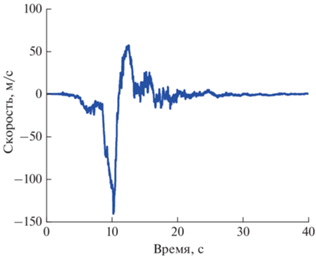
Эффекты направленности проявляются в усилении движений грунта в точках, расположенных по направлению распространения разрыва и определяются геометрическими размерами разлома, положением точки зарождения трещины и скоростью ее распространения, положением точки наблюдения относительно разлома, а также частотным составом интерферирующих волн. Движения грунта, усиленные эффектами направленности, могут быть чрезвычайно разрушительными [Mavroeidis, Papageorgiou, 2003; Kalkan, Kunnath, 2006].
Одна из первых моделей для учета эффектов направленности в GMPE была предложена в работе [Somerville et al., 1997]. Авторы отдельно рассматривали разломы с подвижкой по падению и по простиранию. Предполагалось, что вариации амплитуд движений грунта в приразломных зонах определяются двумя параметрами: (1) углом между направлением распространения трещины и направлением распространения волн из очага к точке наблюдения (φ для первого типа подвижки, θ – для второго); (2) долей ширины d (для первого типа подвижки) либо длины s (для второго типа подвижки) поверхности разрыва, лежащей между гипоцентром и точкой наблюдения. Соответствующие параметры направленности для двух типов подвижки имеют вид: $X~\, = \,\,~\left( {\frac{s}{L}} \right)\cos \theta $, $Y~\,\, = \,\,~\left( {\frac{d}{W}} \right)\cos \varphi $, где L и W – соответственно длина и ширина разломной плоскости. Тогда поправки к оценкам амплитуд спектра реакции по ускорению будут иметь вид:
где ${{C}_{1}}$ и ${{C}_{2}}$ – частотно-зависимые коэффициенты регрессии.Важно отметить, что в рамках этой модели предполагалось, что в случае подвижки по простиранию трещина распространяется только в направлении параллельном простиранию, а в случае подвижки по падению – только в направлении падения. Кроме того, модель не позволяла оценивать эффекты направленности в точках, расположенных вокруг краев разломов с подвижкой по падению, где вводилась так называемая нейтральная зона.
Для преодоления этих недостатков в работе [Abrahamson, 2000] была предложена модификация модели, ограничивающая значения параметров направленности X и Y величиной 0.4, а в работе [Rowshandel, 2006] – обобщение этой модели на случай неоднородных разнонаправленных разрывов, которое позволило расширить область применимости модели.
В работе [Spudich, Chiou, 2008] была предложена аналитическая модель эффектов направленности, основанная на так называемом изохронном предикторе направленности, IDP:
$C\,\,~ = ~\,\,\frac{{\min \left( {\tilde {c}{\kern 1pt} ',2.45} \right) - 0.8}}{{\left( {2.45 - 0.8} \right)}}$ – нормированное отношение скоростей изохрона:
$\tilde {c}{\kern 1pt} '\,\,~ = ~\,\,{{\left( {\frac{\beta }{{{{\nu }_{r}}}} - \frac{{\left( {{{R}_{{HYP}}} - {{R}_{{RUP}}}} \right)}}{D}} \right)}^{{ - 1}}}$, при $D > 0$, $\tilde {c}{\kern 1pt} '~\,\, = \,\,~\frac{{{{\nu }_{r}}}}{\beta }$, при $D~\,\, = \,\,~0$,
где: ${{{{\nu }}}_{r}}$ – скорость распространения разрыва; ${{\beta }}$ – скорость поперечных волн в среде; ${{R}_{{HYP}}}$ и ${{R}_{{RUP}}}$ – гипоцентральное расстояние и кратчайшее расстояние от поверхности разрыва до точки наблюдения ${{x}_{s}}$; $D$ – расстояние от гипоцентра ${{x}_{h}}$ до ближайшей к точке наблюдения точки поверхности разрыва ${{x}_{c}}$.
где $s$ – расстояние от гипоцентра ${{x}_{h}}$ до точки ${{x}_{c}}$ измеренное вдоль простирания разлома; $h$ – расстояние от верхней кромки разрыва до гипоцентра измеренное вдоль падения разлома.${{R}_{{ri}}}~\,\, = ~\max \left( {\sqrt {R_{u}^{2} + R_{t}^{2}} ,\varepsilon } \right)$ – скалярная амплитуда диаграммы направленности, где ${{R}_{t}}$ и ${{R}_{u}}$ – нормальная к простиранию и параллельная простиранию компоненты диаграммы направленности излучения, $\varepsilon ~\, = \,~0.2$.
Итоговая модель эффекта направленности имеет вид:
где ${{f}_{R}}\left( {{{R}_{{RUP}}}} \right)~\, = ~\,{\text{max}}\left[ {0,\left( {1 - \frac{{{\text{max}}\left( {0,{{R}_{{RUP}}} - 40} \right)}}{{30}}} \right)} \right]$ принимает значение 1 для $0 \leqslant {{R}_{{RUP}}} \leqslant 40$ и линейно снижается до 0 при ${{R}_{{RUP}}} \geqslant 70$, ${{f}_{M}}\left( M \right)~\,\, = ~$ $ = ~\min \left[ {1,\frac{{{\text{max}}\left( {0,M - 5.6} \right)}}{{0.4}}} \right]$ принимает значение 0 при $0 \leqslant M \leqslant 5.6$ и линейно возрастает до 1 при $M \geqslant 6.0$, $a$ и $b$ – частотно-зависимые коэффициенты регрессии.
Сравнивая модель изохронного предиктора с моделями в работах [Somerville et al., 1997; Abrahamson, 2000], авторы модели отмечают, что прогнозируемое данной моделью усиление и ослабление движений грунта примерно соответствует оценкам, получаемым по модели [Abrahamson, 2000] и практически вдвое ниже оценок модели [Somerville et al., 1997] для всех спектральных периодов.
В описанных выше моделях влияние эффектов направленности выражается в монотонном усилении или ослаблении амплитуд спектра реакции по ускорению в широком диапазоне спектральных периодов, поэтому такие модели иногда называют широкополосными. С другой стороны, некоторые авторы (например, [Somerville, 2005; Tothong et al., 2007; Iervolino et al., 2012]) отмечают, что согласно имеющимся данным наблюдений, эффекты направленности проявляются в узком диапазоне спектральных периодов, близких к периоду импульса волновой формы (${{T}_{p}})$, такие модели называют узкополосными.
Развивая подход, предложенный в работах [Tothong et al., 2007], авторы работы [Shahi, Baker, 2011] предложили всеобъемлющую процедуру для учета эффектов импульсных волновых форм в вероятностном анализе сейсмической опасности (ВАСО). Процедура задействует алгоритм идентификации импульсных волновых форм [Baker, 2007], избавляющий от неоднозначности интерпретации данных, возникающей при визуальном анализе записей землетрясений. Другими важными элементами процедуры являются: модель вероятности возникновения импульсных движений грунта в пункте наблюдения в зависимости от расположения относительно очага землетрясения, модель вероятности возникновения импульсных движений грунта конкретной ориентации, модель зависимости периода импульса от магнитуды землетрясения и модель усиления компонент спектра реакции по ускорению в зависимости от периода импульса.
Перечисленные модели были откалиброваны на подмножестве импульсных волновых форм из базы данных проекта NGA, идентифицированных с помощью алгоритма [Baker, 2007]. В качестве демонстрации применения процедуры были рассчитаны карты сейсмической опасности в единицах спектральных ускорений на периоде 5 с для разлома с подвижкой по простиранию с использованием предлагаемой процедуры и с использованием обычного ВАСО. На основе этих результатов была рассчитана карта приращений сейсмической опасности относительно обычного ВАСО в приразломной зоне. Для сравнения аналогичная карта приращений была рассчитана на основе модели [Abrahamson, 2000]. Обе карты давали близкие значения приращений сейсмической опасности, при этом приращения, полученные с помощью описанной процедуры, были сконцентрированы в гораздо более узкой области вокруг разлома, чем приращения полученные с помощью модели [Abrahamson, 2000]. Значительные различия вероятно обусловлены уточнением модели эффектов направленности, обеспеченным существенно расширенной базой данных, накопленной за время, прошедшее после публикаций [Somerville et al., 1997; Abrahamson, 2000].
В статье [Spanguolo et al., 2016] модель эффектов направленности из работы [Spudich, Chiou, 2008] была использована для построения карт сейсмической опасности окрестностей города Стамбул. Сейсмическая опасность в этом регионе обусловлена близостью двух сегментов Северо-Анатолийского разлома, проходящих по дну Мраморного моря на расстоянии порядка 20 км от Стамбула. Положение гипоцентра на сегментах разлома моделировалось случайными величинами с нормальным распределением, равномерным распределением, а также распределением, определенным на основе моделирования процессов распространения трещины. Результаты анализа показали, что учет эффектов направленности приводит к значительному повышению оценок ВАСО, до 25% для сейсмической опасности с периодом повторяемости 475 лет, выраженной в единицах спектральных ускорений на периоде 2 с.
Многие перечисленные результаты [Rowshandel, 2006; Baker, 2007; Tothong et al., 2007; Spudich, Chiou, 2008; Shahi, Baker, 2011] стали возможны благодаря обширной базе данных проекта NGA, что лишний раз подчеркивает важность работ по накоплению и анализу записей землетрясений.
Приведенный обзор показывает, что учету эффектов направленности в анализе сейсмической опасности было уделено достаточно большое внимание. Созданы разнообразные модели оценки влияния этих эффектов на движения грунта, сформулированы процедуры их включения в расчеты ВАСО. Показано, что повышение оценок сейсмической опасности в приразломных зонах вследствие влияния эффектов направленности может быть весьма существенным.
Однако на сегодняшний день остается ряд дискуссионных вопросов, по которым не удалось достигнуть консенсуса. Так, разные авторы по-разному определяют магнитудный порог, выше которого ожидается проявление эффектов направленности, встречаются значения M > 6.0, 6.5, 7.0. Нет консенсуса относительно размеров пространственных областей, окружающих разломы, в которых ожидается проявление эффектов направленности. Также нет консенсуса в вопросе о том, широкополосные или узкополосные модели корректнее описывают влияние эффектов направленности на движения грунта. Очевидно, с накоплением новых данных и уточнением моделей, эти вопросы удастся разрешить.
ФИНАНСИРОВАНИЕ РАБОТЫРабота выполнена при поддержке РНФ, грант 23-27-00316.
Список литературы
Abrahamson N.A. Seismological aspects of near-fault ground motions. Proc. of the 5th Caltrans Seismic Research Workshop. California Department of Transportation. 1998.
Abrahamson N.A. Effects of rupture directivity on probabilistic seismic hazard analysis. Proc. of the EERI 6th Seismic Zonation Workshop. Palm Springs. California. 2000. 6 p.
Acarel D., Cambaz M.D., Turhan F., Mutlu A.K., Polat R. Seismotectonics of Malatya Fault, Eastern Turkey // Open Geosciences 2019. V. 11. № 1. P. 1098–1111.
Akkar S., Yazgan U., Gulkan P. Drift estimates in frame buildings subjected to near-fault ground motions // J. Struct. Eng. 2005. V. 131. № 7. P. 1014–1024.
Alavi B., Krawinkler H. Effects of near-fault ground motions on frame structures. Technical Report Blume Center Report. 2001. V. 138. 301 p.
Anderson J.C., Bertero V. Uncertainties in establishing design earthquakes // J. Struct. Eng. 1987. V. 113. № 8. P. 1709–1724.
Andrews D.J. Rupture velocity of plane strain shear cracks // J. Geophys. Res. 1976. V. 81. P. 5679–5687.
Applied Technology Council. Improved seismic design criteria for California bridges: provisional recommendations. Report № ATC-32. Redwood City, California. 1996.
Baez J.I., Miranda E. Amplification Factors to Estimate Inelastic Displacement Demands for the Design of Structures in the Near Field. Proc. of 12th World Conference on Earthquake Engineering. 2000.
Baker J.W. Quantitative classification of near-fault ground motions using wavelet analysis // Bull. Seismol. Soc. Am. 2007. V. 97. № 5. P. 1486–1501. https://doi.org/10.1785/0120060255
Baltzopoulos G., Luzi L., Iervolino I. Analysis of Near-Source Ground Motion from the 2019 Ridgecrest Earthquake Sequence // Bull. Seismol. Soc. Am. 2020. V. 110. № 4. P. 1495–1505. https://doi.org/10.1785/0120200038
Baltzopoulos G., Baraschino R., Chioccarelli E., Cito P., Iervolino I. Preliminary engineering report on ground motion data of the Feb. 2023. Turkey seismic sequence. V1.0. 2023.
Bertero V., Mahin S., Herrera R. Problems in prescribing reliable design earthquakes. Proc. 6th World Conference on Earthquake Engineering. 1977. V. 2. P. 1741–1746.
Bertero V., Mahin S., Herrera R. Aseismic design implications of near-fault San Fernando earthquake records // Earthq. Eng. Struct. Dynam. 1978. V. 6. № 1. P. 31–42.
Bhat H.S., Dmowska R., Rice J.R., Kame N. Dynamic slip transfer from the Denali to Totschunda faults, Alaska: Testing theory for fault branching // Bull. Seismol. Soc. Am. 2004. V. 94. № 6B. P. S202-S213. https://doi.org/10.1785/0120040601
Bommer J., Akkar S., Drouet S. Extending ground-motion prediction equations for spectral accelerations to higher response frequencies // Bull. Earthq. Eng. 2012. V. 10. № 2. P. 379–399
Bouchon M., Bouin M-P., Karabulut H., Toksöz M.N., Dietrich M., Rosakis A.J. How fast is rupture during an earthquake? New insights from the 1999 Turkey earthquakes // Geophys. Res. Lett. 2001. V. 28. № 14. P. 2723–2726. https://doi.org/10.1029/2001GL013112
Dunham E., Archuleta R. Evidence for a supershear transient during the 2002 Denali fault earthquake // Bull. Seismol. Soc. Am. 2004. V. 94. № 6B. P. S256–S268.
Dunham E., Bhat H. Attenuation of radiated ground motion and stresses from three-dimensional supershear ruptures // J. Geophysical Research. Solid Earth 2008. V. 113. P. B8.
Federal Emergency Management Agency (FEMA), NEHRP guidelines for the seismic rehabilitation of buildings. Reports FEMA 273 (Guidelines) and 274 (Commentary).Washington: D.C. 1997.
Garini E., Gazetas G. Second Preliminary Report (8-2-23) Emergence of Fault Rupture. Accelerograms NTUA. Greece. 2023.
Giardini D., Danciu L., Erdik M., Demircioglu M., Sesetyan K., Demircioglu M., Akkar S., Gulen L., Zare M. Seismic hazard map of the Middle East // Bull. Earthq. Eng. 2018. V. 16. P. 1–4. https://doi.org/10.1007/s10518-018-0347-3
Gülerce Z., Tanvir Shah S., Menekşe A., Arda Özacar A., Kaymakci N., Önder Çetin K. Probabilistic Seismic-Hazard Assessment for East Anatolian Fault Zone Using Planar Fault Source Models // Bull. Seismol. Soc. Am. 2017. V. 107. № 5. P. 2353–2366. https://doi.org/10.1785/0120170009
Hall J., Heaton T., Halling M., Wald D. Near-source ground motion and its effects on flexible buildings // Earthq. Spectra. 1995. V. 11. № 4. P. 569–605.
Harris R., Day S. Dynamics of fault interaction: Parallel strike-slip faults // J. Geophys. Res.: Solid Earth. 1993. V. 98. № B3. P. 4461-4472
Iervolino I., Chioccarelli E., Baltzopoulos G. Inelastic displacement ratio of near-source pulse-like ground motions. Earthq. Eng. Struct. Dynam. 2012. https://doi.org/10.1002/eqe.2167
Iervolino I., Cito P., Felicetta C., Lanzano G., Vitale A. Exceedance of design actions in epicentral areas: insights from the Shake Map envelopes for the 2016–2017 central Italy sequence // Bull. Earthq. Eng. 2021. V. 19. № 13. P. 5391–5414. https://doi.org/10.1007/ s10518-021-01192-z
Iwan W. Drift spectrum: Measure of demand for earthquake ground motions // J. Struct. Eng. 1997. V. 123. № 4. P. 397–404.
Kalkan E., Kunnath S.K. Effects of fling-step and forward directivity on the seismic response of buildings // Earthq. Spectra. 2006. V. 22. № 2. P. 367–390.
Kartal R., Kadirioğlu F., Zünbül S. Kinematic of east Anatolian fault and Dead Sea fault. Conference Paper. 2013. https://www.researchgate.net /publication/271852091
Luco N., Cornell C. Structure-specific scalar intensity measures for near-source and ordinary earthquake ground motions // Earthq. Spectra. 2007. V. 23. № 2. P. 357–392.
Makris N., Black C. Dimensional analysis of bilinear oscillators under pulse-type excitations // J. Eng. Mech. 2004. V. 130. № 9. P. 1019–1031.
Mahin S., Bertero V., Chopra A., Collins R. Response of the Olive View hospital main building during the San Fernando earthquake. Report No. UCB/EERC-76/22. Earthquake Engineering Research Center. University of California at Berkeley. 1976
Malhotra P. M 7.8 Turkey Earthquake of February 6. 2023.
Mavroeidis G.P., Papageorgiou A.S. A mathematical representation of near-fault ground motion // Bull. Seismol. Soc. Am. 2003. V.93. P. 1099–1131.
Mavroeidis G., Dong G., Papageorgiou A. Near-fault ground motions, and the response of elastic and inelastic single degree- of-freedom (SDOF) systems // Earthq. Eng. Struct. Dynam. 2004. V. 33. № 9. P. 1023–1049.
Mello M., Bhat H.S., Rosakis A.J., Kanamori H. Reproducing the supershear portion of the 2002 Denali earthquake rupture in laboratory // Earth Planet. Sci. Lett. 2014. V. 387. P. 89–96.
Mello M., Bhat H., Rosakis A. Spatiotemporal properties of Sub-Rayleigh and supershear rupture velocity fields: Theory and experiments // J. Mech. Phys. Solids. 2016. V. 93. P. 153–181.
Menun C., Fu Q. An analytical model for near-fault ground motions and the response of SDOF systems. Proc. 7th U.S. National Conf. Earthquake Engineering. 2002. P. 10.
Mohamed Abdelmeguid M., Zhao C., Yalcinkaya E., Gazetas G., Elbanna A., Rosakis A. Revealing the dynamics of the Feb 6th 2023 M7.8 Kahramanmaraş. Pazarcik earthquake: near-field records and dynamic rupture modeling. This paper is a non-peer reviewed preprint submitted to EarthArXiv.
Montaldo V., Faccioli E., Zonno G., Akinci A., Malagnini L. Treatment of ground-motion predictive relationships for the reference seismic hazard map of Italy // J. Seismol. 2005. V. 9. № 3. P. 295–316. https://doi.org/10.1007/s10950-005-5966-x
Rosakis A., Samudrala O., Coker D. Cracks faster than the shear wave speed // Science. 1999. V. 284. № 5418. P. 1337–1340.
Rosakis A., Abdelmeguid M., Elbanna A. Evidence of Early Supershear Transition in the Mw 7.8 Kahramanmaraş Earthquake From Near-Field Records. non-peer reviewed preprint. 2023.
Rousseau C.-E., Rosakis A. Dynamic path selection along branched faults: Experiments involving sub-Rayleigh and supershear ruptures // J. Geophys. Res.: Solid Earth. 2009. V. 114. P. B8.
Rowshandel B. Incorporating source rupture characteristic into ground-motion hazard analysis models // Seism. Res. Lett. 2006. V. 77. № 6. P. 708–722.
Shahi S., Baker J. An empirically calibrated framework for including the effects of near-fault directivity in probabilistic seismic hazard analysis // Bull. Seismol. Soc. Am. 2011. V. 101. № 2. P. 742–755. https://doi.org/10.1785/0120100090
Somerville P., Smith N., Graves R., Abrahamson N. Representation of near-fault rupture directivity effects in design ground motions, and application to Caltrans bridges. Proc. National Seismic Conf. on Bridges and Highways. San Diego. California. 1995.
Somerville P., Saikia C., Wald D., Graves R. Implications of the Northridge earthquake for strong ground motions from thrust faults // Bull. Seismol. Soc. Am. 1996. V. 86. № 1. Part B. P. S115–S125.
Somerville P., Smith N., Graves R., Abrahamson N. Modification of Empirical Strong Ground Motion Attenuation Relations to Include the Amplitude and Duration Effects of Rupture Directivity // Seismol. Res. Lett. 1997. V. 68. № 1. P. 199–222. https://doi.org/10.1785/ gssrl.68.1.199
Somerville P. Magnitude scaling of the near fault rupture directivity pulse // Phys. Earth Planet. In. 2003. V. 137. № 1. P. 201–212.
Somerville P. Engineering characterization of near fault ground motion. New Zealand Society for Earthquake Engineering Conference. 2005. P. 8.
Spagnuolo E., Akinci A., Herrero A., Pucci S. Implementing the effect of the rupture directivity on PSHA for the city of Istanbul, Turkey // Bull. Seismol. Soc. Am. 2016. V. 106. № 6. P. 2599–2613. https://doi.org/10.1785/0120160020
Spudich P. Chiou B.S. Directivity in NGA earthquake ground motions: Analysis using isochrone theory // Earthq. Spectra. 2008. V. 24. № 1. P. 279–298.
Taftsoglou M., Valkaniotis S., Karantanellis E., Goula E., Papathanassiou G. Preliminary mapping of liquefaction phenomena triggered by the February 6 2023 M7.7 earthquake, Türkiye. Syria, based on remote sensing data. Zenodo. 2023. https://doi.org/10.5281/zenodo.7668401
Templeton E., Baudet A., Bhat H.S., Dmowska R., Rice J.R., Rosakis A.J., Rousseau C-E. Finite element simulations of dynamic shear rupture experiments and dynamic path selection along kinked and branched faults // J. Geophys. Res.: Solid Earth 2009. V. 114. P. B8. https://doi.org/10.1029/2008JB006174
Tothong P., Cornell C.A., Baker J. Explicit directivity-pulse inclusion in probabilistic seismic hazard analysis // Earthq. Spectra. 2007. V. 23. № 4. P. 867–891. https://doi.org/10.1193/1.2790487
Turkish National Strong Motion Network [Data set]. Department of Earthquake, Disaster and Emergency Management Authority. https://doi.org/ (accessed 02/13/2023 7:30 PM PST)https://doi.org/10.7914/SN/TK
Uniform Building Code // Int. Conf. of Bldg. Officials, Whittier, California. 1997.
U.S. Geological Survey. URL: https://earthquake. usgs.gov/earthquakes/eventpage/us6000jllz/origin/detail (accessed 02/13/2023 7:30 PM PST)
Zeng H., Wei S., Rosakis A. A Travel-Time Path Calibration Strategy for Back-Projection of Large Earthquakes and Its Application and Validation Through the Segmented Super-Shear Rupture Imaging of the 2002 Mw 7.9 Denali Earthquake // J. Geophys. Res.: Solid Earth. 2022. V. 127. № 6. e2022JB024359.
Дополнительные материалы отсутствуют.


